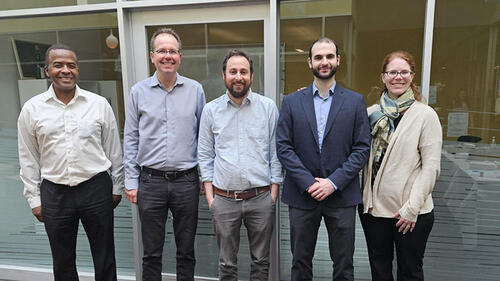
On Friday, April 7, 2023, Giacomo Scanavini successfully defended his thesis, “First measurement of neutral-current neutral pion production differential cross sections on argon” (advisors Bonnie Fleming and Karsten Heeger).
Scanavini explained, “My dissertation provides the first differential cross section measurements of neutral-current pion production in argon using the MicroBooNE Liquid Argon Time Projection Chamber (LArTPC). These measurements are further broken down based on the number of protons (zero or at least one) to test popular models’ performance in a context where nuclear effects are highly relevant. The lack of data on argon in the neutrino energy range up to a few GeV is a sufficient condition to carry out these measurements for improving our understanding of neutrino interactions and modeling but, in addition, they have ties to future high-precision oscillation experiments. With a sophisticated reconstruction chain, high-level information is extracted from the detector and used in a Boosted Decision Tree (BDT) to identify signal-like events. Finally, the final measurements are also compared to some popular neutrino events generators, revealing important information regarding the necessity to update interaction models with the now available high statistical measurement results.
Thesis abstract:
Neutral current neutral pion interactions are a fundamental process in neutrino interactions, and their study in the MicroBooNE Liquid Argon Time Projection Chamber (LArTPC) is crucial in advancing our understanding of accelerator neutrino experiments. On one hand, the anomalous excess of electron-like events observed by the MiniBooNE experiment can be probed through a single-gamma search in MicroBooNE. On the other hand, future measurements of neutrino oscillations in DUNE will require precise measurements of neutrino interactions to reduce uncertainties associated with cross section modeling. As the major source of background for both studies, neutral-current neutral pion interactions in a LArTPC can easily mimic single-photon and electron events signatures and, therefore, must be carefully evaluated.